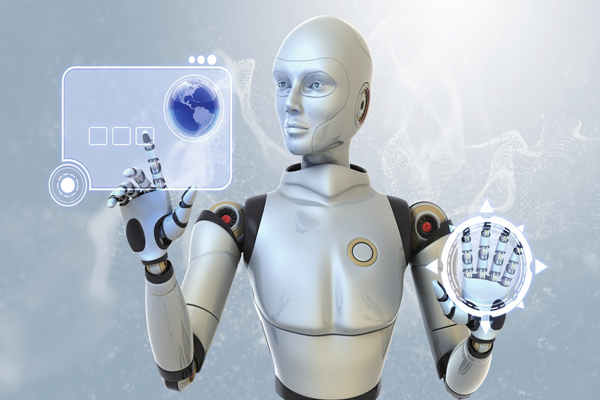China's humanoid robot market to hit 10 billion yuan, eyes 119 billion yuan by 2030: report

[Photo/VCG]
Research unveiled during the inaugural China Humanoid Robot Industry Conference in Beijing from April 9 to 10 indicates that the global humanoid robot industry is entering a golden era, poised for sustained growth. The report predicted that the Chinese humanoid robot market will surpass 10 billion yuan, reaching 10.47 billion yuan ($1.45 billion) by 2026, and is anticipated to soar to 119 billion yuan by 2030.
The booming market is seemingly telling people that intelligent humanoid robots that can simulate human thinking and consciousness, as depicted in films like Ex Machina and A.I. Artificial Intelligence, are really getting closer to reality.
The rapid development of AI technology has played a crucial role in the advancement of humanoid robots. As NVIDIA CEO Jensen Huang said at the 2024 GPU Technology Conference (GTC) in March, "Building foundation models for general humanoid robots is one of the most exciting problems to solve in AI today."
In return, the advancement of humanoid robots is viewed as a major milestone in the AI era, pushing the boundaries of AI research. Numerous Chinese experts and industry observers consider humanoid robots a breakthrough for the "AI Plus" initiative aimed at fostering innovative development in the digital economy, as promoted during the two sessions in March.
Golden age along with AI
Humanoid robots are dubbed "humanoid" because they are designed to emulate and potentially surpass human capabilities in form, function, behavior, and even cognitive processes, Zhang Rui, founder and executive director of the Beijing Ironman Technology in Beijing, told the Global Times.
"Without the need for massive changes to the existing environment, humanoid robots can seamlessly integrate into various scenarios, using their flexible and dynamic execution capabilities to meet complex and changing task requirements. Furthermore, their human-like characteristics enable them to easily manipulate human tools, further expanding their application areas," Zhang said.
Therefore, humanoid robots are not only a symbol of technological progress but also a significant force driving future social development, he noted.
Humanoid robots have been widely applied in various industries, with the aerospace sector being one of the most prominent, according to Zhang. Several countries including the US, Russia and China, have been deeply researching the application of humanoid robots in the aerospace field. These robots are mainly used to replace humans in performing dangerous and complex operations, ensuring the safety of astronauts and improving the efficiency and success rate of space missions.
Other major application areas of humanoid robots is in border defense and lights-out factories, or smart factories.
"The continuous innovation and breakthroughs in AI technology in recent years have indeed provided humanoid robots with more powerful perception, decision-making, and execution capabilities. This allows humanoid robots to more accurately understand human language, recognize environmental information, and make more reasonable decisions and actions," Zhang said.
In the future, Zhang expects humanoid robots to have enormous potential in areas such as general hardware execution, dynamic adaptation and environmental integration.
How far is AGI?
The thriving progress of humanoid robots is drawing increasing attention from international tech giants. On March 18, nine humanoid robots were unveiled at NVIDIA's 2024 GTC. Tesla is also actively working on a humanoid robot named Optimus, and OpenAI, Microsoft, and Amazon founder Jeff Bezos have made substantial investments in humanoid robot startup Figure AI. Additionally, Agility Robotics, backed by Amazon, has established the world's first large-scale humanoid robot production factory in Oregon, the US, capable of producing 10,000 two-legged robots annually.
A group of innovative and competitive Chinese companies have also emerged in the field of humanoid robots with the increasing emphasis and investment in robot technology in China, leading to significant progress in the Chinese humanoid robot industry.
In March, the Beijing humanoid robot innovation center announced that it would soon release the first generation of a universal open humanoid robot body.
Among the nine robots showcased at the NVIDIA 2024 GTC, two were developed by Chinese companies, namely H1 from Hangzhou Unitree Robotics and PX5 from Xiaopeng Pengxing.
The Global Times learned from Unitree Robotics that H1 is a full-size humanoid robot capable of running, equipped with 360 panoramic depth perception. Currently, it can reach a speed of 3.3 meters per second, setting a world record for full-size electric humanoid robots, with a potential speed of up to 5 meters per second.
This robot boasts highly advanced full-body dynamic coordination capabilities, enabling it to dance in groups and execute backflips. As a result, NVIDIA opted to partner with Yushu to collectively propel the global advancement of AI robots. According to the company's response to the Global Times, NVIDIA, a frontrunner in GPU and AI chip technology, furnishes Yushu's robots with robust computing capabilities and comprehensive support in deep learning technology.
However, overall, the deep integration of AI and humanoid robots still faces significant challenges.
Zhang believes hardware challenges are a crucial obstacle. While we can achieve various complex functions and performance at the algorithm level, it is often difficult to achieve the desired output power and efficiency in actual robot hardware, he said.
This is mainly due to the numerous technical details and engineering challenges involved in hardware design and manufacturing, requiring continuous optimization and improvement, Zhang explained.
On the other hand, the current progress of AI technology is mainly limited to deepening and innovating at the logical level, with insufficient breakthroughs in thinking and emotional aspects. While the form of robots is malleable, the "spirit" of their internal thinking and emotions is still an unexplored frontier. Zhang believes it will take another 5-10 years to achieve a 70 percent similarity with human emotions.
At an economic forum held at Stanford University in March, Jensen Huang predicted that a general artificial intelligence that can pass human tests, or "human-like" artificial general intelligence (AGI, capable of performing all human intelligent behaviors), is likely to appear within five years. However, Huang also pointed out that achieving this goal is not without difficulties, as scientists still lack a unified definition of how the human mind operates, making it challenging for engineers to achieve the goal.
On April 8, Elon Musk said during a livestreamed interview on X that AI that is smarter than any one human will probably come around by the end of next year. Last year, he predicted that humans would "fully" achieve general artificial intelligence by 2029.
Some experts believe that with the continuous advancement of chips and algorithms, AI may eventually surpass human intelligence. However, Liu Wei, director of the human-machine interaction and cognitive engineering laboratory of the Beijing University of Posts and Telecommunications, pointed out that AGI may be a false proposition. This is not because current AI systems have not reached the level of general intelligence, but because AI fundamentally perform and learn like humans.
The development of AGI faces three major bottlenecks: technical, biological, and social. The technical bottleneck lies in the need for AI systems to have higher computing power, more advanced algorithms, and more efficient data processing methods to achieve more complex and intelligent functions. The biological bottleneck mainly stems from our limited understanding of the cognitive capabilities and operation mechanisms of the human brain, requiring deeper research in neuroscience and cognition to achieve similar levels of intelligence. The social bottleneck includes the integration of AI systems with human society, such as cultural differences, ethical issues, privacy protection, etc., all of which are crucial factors affecting the development of AI, according to Liu.
"To overcome these bottlenecks, interdisciplinary cooperation and continuous innovation efforts are needed. Only by making breakthroughs in technology, biology and society can AGI move towards more mature and comprehensive development, but it remains extremely difficult, perhaps impossible after all," Liu said.
Safety and ethics concerns
In November 2023, the Ministry of Industry and Information Technology of China issued the guiding opinions on the innovation and development of humanoid robots, proposing to establish a preliminary innovation system for humanoid robots by 2025.
The document predicted that, by 2025, key technologies such as those related to robots' "brain, cerebellum, limbs" will achieve breakthroughs, ensuring safe and effective supply of core components. The whole machine products will reach international advanced levels, achieve mass production, and be demonstrated in special, manufacturing, and civil service scenarios, exploring effective governance mechanisms and means. By 2027, China's comprehensive strength in humanoid robots will reach world-class levels, becoming an important new engine for economic growth.
The development of the humanoid robot industry, driven by both technology and policy, has entered the fast lane of development, but it also faces challenges in safety, social ethics, and legal norms. Some experts point out that in scenarios requiring close contact, such as in elderly care or assistance, where physical contact is needed, the safety and risk issues of humanoid robots cannot be underestimated. More research is needed by the industry and relevant regulatory authorities on the technical and application scenarios.
Zhang believes that when unexpected situations occur with humanoid robots in a home environment, the lack of clear legal definitions makes it difficult to determine responsibility and protect rights. Additionally, there is currently no mandatory system for certifying the eligibility of humanoid robot products, making it challenging to distribute products in large quantities and limiting the widespread application of humanoid robots. Therefore, it is essential to address and resolve these legal gaps as soon as possible to ensure the healthy and orderly advancement of humanoid robots in the future.
However, he firmly believes that with the continuous progress of technology and the gradual improvement of regulations, humanoid robots will demonstrate their unique charm in more fields, contributing more to the development of human society.
In 2023, the Chinese Ministry of Science and Technology, together with the Ministry of Education, the Ministry of Industry and Information Technology, and 10 other departments, issued the trial ethical review measures for science and technology.
According to the measures, carrying out scientific and technological activities should adhere to the unity of promoting innovation and preventing risks. It involves objectively evaluating and prudently handling uncertainties and risks of technological applications, following the principles of enhancing human well-being, respecting the rights of life, upholding fairness and justice, reasonably controlling risks, and maintaining openness and transparency in science and technology ethics. It is essential to comply with the Constitution, laws, and regulations of China, relevant provisions, and ethical norms of science and technology.

 Ningbo seabird project seeks international volunteers
Ningbo seabird project seeks international volunteers  Jakub's journey: From shipyard to sea
Jakub's journey: From shipyard to sea  Badminton Asia COO applauds Ningbo
Badminton Asia COO applauds Ningbo 


